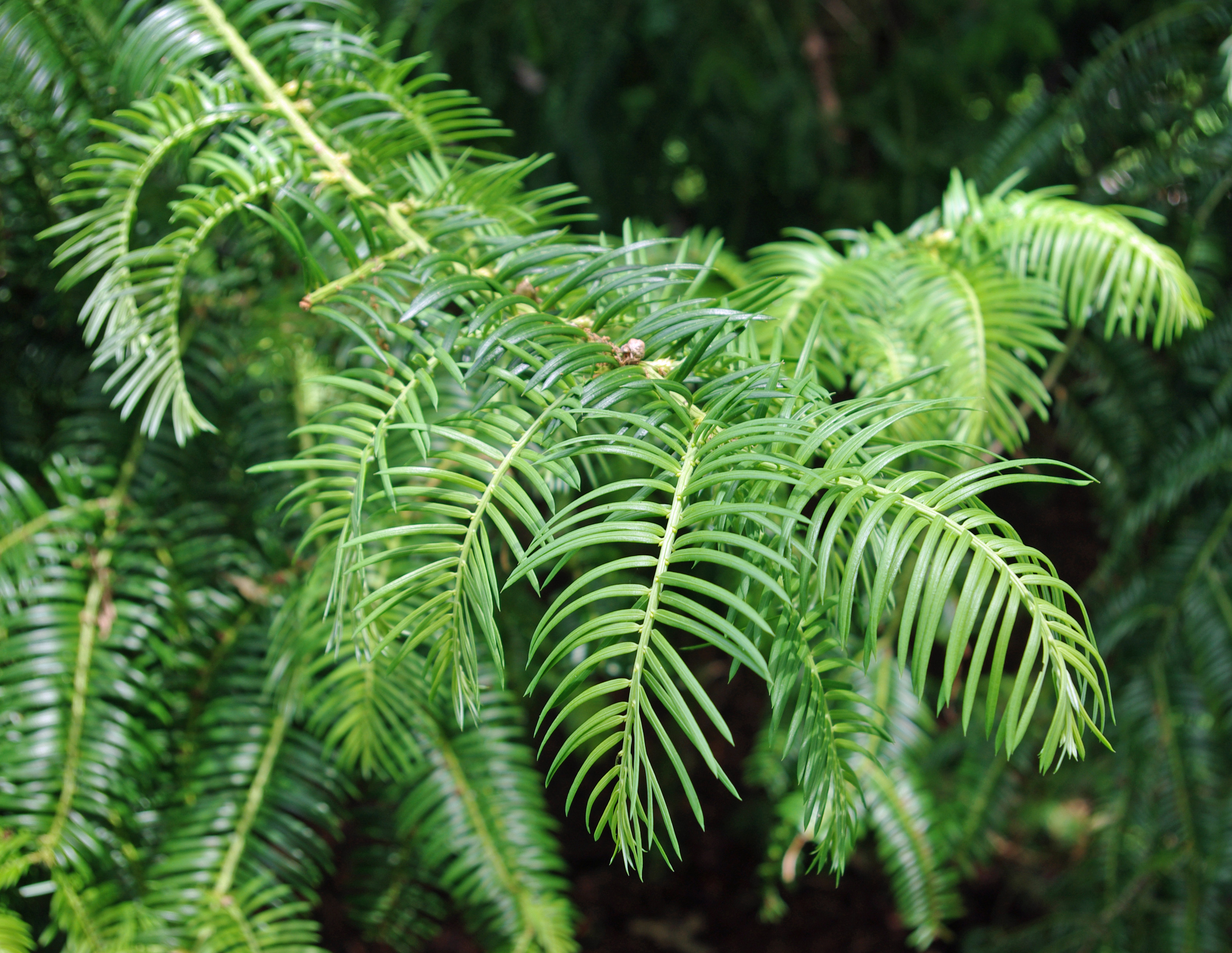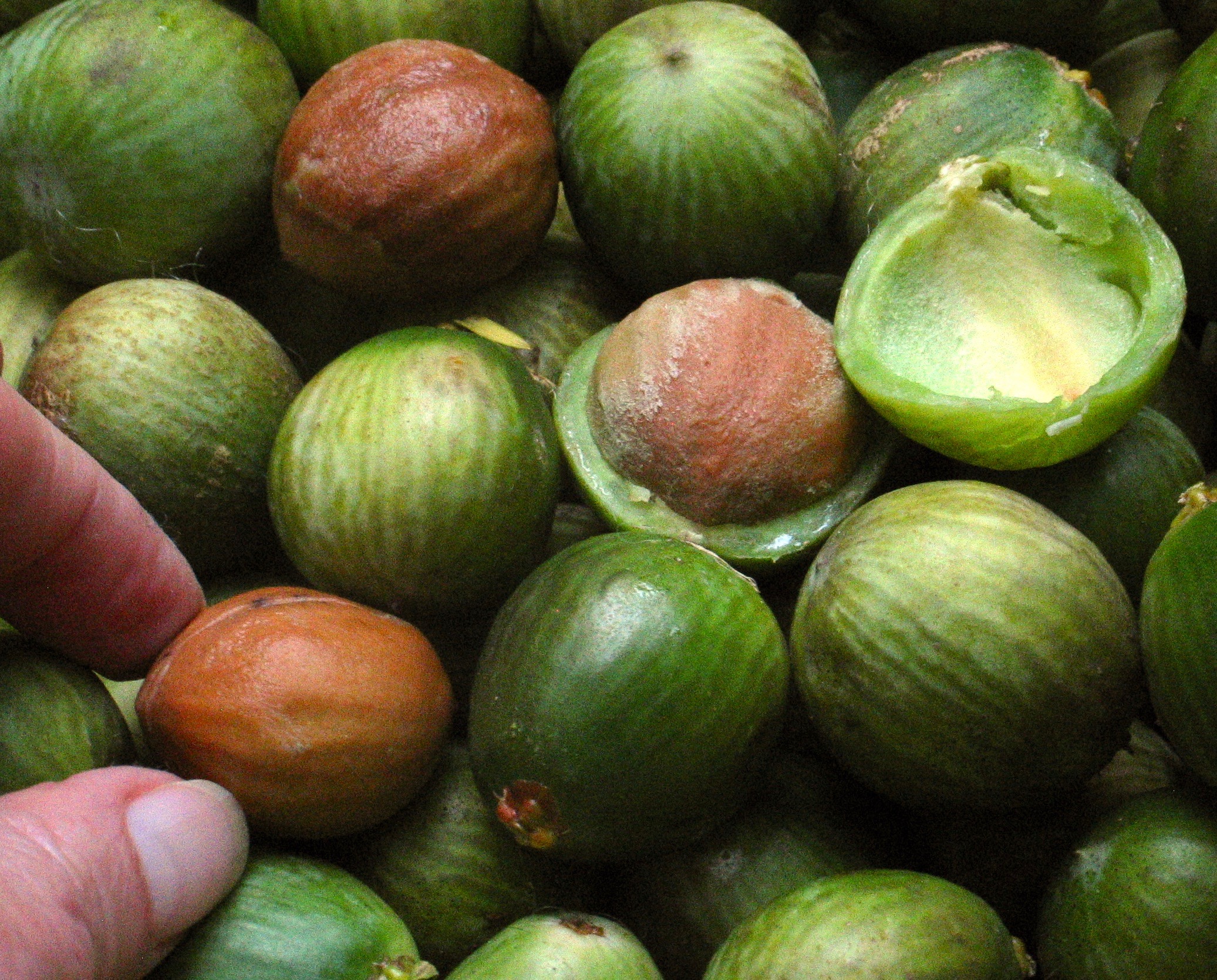|
Taxaceae
Taxaceae (), commonly called the yew family, is a coniferous family (biology), family which includes six Extant taxon, extant and two extinct genera, and about 30 species of plants, or in older interpretations three genera and 7 to 12 species. Description They are many-branched, small trees and shrubs. The leaves are evergreen, spirally arranged, often twisted at the base to appear 2-ranked. They are linear to lanceolate, and have pale green or white stomatal bands on the undersides. The plants are Plant sexuality, dioecious, or rarely Plant sexuality, monoecious. The catkin like male cones are long, and shed pollen in the early spring. They are sometimes externally only slightly differentiated from the branches. The fertile bracts have 2-8 pollen sacs. The female 'cones' are highly reduced. Only the upper or uppermost bracts are fertile and bear one or rarely two seeds. The ovule usually exceeds the scale, although ovules are sometimes rarely enclosed by it. They may be foun ... [...More Info...] [...Related Items...] OR: [Wikipedia] [Google] [Baidu] |
Conifer
Conifers () are a group of conifer cone, cone-bearing Spermatophyte, seed plants, a subset of gymnosperms. Scientifically, they make up the phylum, division Pinophyta (), also known as Coniferophyta () or Coniferae. The division contains a single extant class (biology), class, Pinopsida. All Neontology, extant conifers are perennial plant, perennial woody plants with secondary growth. The majority are trees, though a few are shrubs. Examples include Cedrus, cedars, Pseudotsuga, Douglas-firs, Cupressaceae, cypresses, firs, junipers, Agathis, kauri, larches, pines, Tsuga, hemlocks, Sequoioideae, redwoods, spruces, and Taxaceae, yews.Campbell, Reece, "Phylum Coniferophyta". ''Biology''. 7th ed. 2005. Print. p. 595. As of 2002, Pinophyta contained seven families, 60 to 65 genera, and more than 600 living species. Although the total number of species is relatively small, conifers are ecology, ecologically important. They are the dominant plants over large areas of land, most notably ... [...More Info...] [...Related Items...] OR: [Wikipedia] [Google] [Baidu] |
Pinales
The order Pinales in the division Pinophyta, class Pinopsida, comprises all the extant conifers. The distinguishing characteristic is the reproductive structure known as a cone produced by all Pinales. All of the extant conifers, such as Araucaria, cedar, celery-pine, cypress, fir, juniper, kauri, larch, pine, redwood, spruce, and yew, are included here. Some fossil conifers, however, belong to other distinct orders within the division Pinophyta. Multiple molecular studies indicate this order being paraphyletic with respect to Gnetales, with studies recovering Gnetales as either a sister group to Pinaceae or being more derived than Pinaceae but sister to the rest of the group. Taxonomy History Brown (1825) first discerned that there were two groups of seed plants, distinguished by the form of seed development, based on whether the ovules were exposed, receiving pollen directly, or enclosed, which do not. Shortly afterwards, Brongniart (1828) coined the term '' Phané ... [...More Info...] [...Related Items...] OR: [Wikipedia] [Google] [Baidu] |
Torreya
''Torreya'' is a genus of conifers comprising six or seven species placed in the family Taxaceae, though sometimes formerly placed in Cephalotaxaceae. Four species are native to eastern Asia; the other two are native to North America. They are small to medium-sized evergreen trees reaching 5–20 m, rarely 25 m, tall. Common names include nutmeg yew. The genus is one example of the Arcto-Tertiary Geoflora in paleoecology. The pattern of highly disjunct distribution of geographic ranges of the species within such a genus spans temperate plant zones of continents in the Northern Hemisphere. This geographic pattern is attributed to genus origins in much warmer times of the Tertiary Period, when zones of temperate climate were found in poleward latitudes whereby land connections facilitated range expansions and migrations of plants between Asia and North America and sometimes between Europe and North America. The leaves are spirally arranged on the shoots, but twisted at the b ... [...More Info...] [...Related Items...] OR: [Wikipedia] [Google] [Baidu] |
Cephalotaxus Sinensis 1
''Cephalotaxus'', commonly called plum yew or cowtail pine, is a genus of conifers comprising 11 species, either considered the only member of the family Cephalotaxaceae, or in the Taxaceae when that family is considered in a broad sense. The genus is endemic to eastern Asia, though fossil evidence shows it had a wider Northern Hemisphere distribution in the past. The species are evergreen shrubs and small trees reaching (rarely to ) tall. Description The leaves are spirally arranged on the shoots, but twisted at the base to lie in two flat ranks (except on erect leading shoots); they are linear, long and broad, soft in texture, with a blunt tip; this helps distinguish them from the related genus ''Torreya'', which has spine-tipped leaves. The species can be either monoecious or dioecious; when monoecious, the male and female cones are often on different branches. The male (pollen) cones are long, grouped in lines along the underside of a shoot. The female (seed) cones are ... [...More Info...] [...Related Items...] OR: [Wikipedia] [Google] [Baidu] |
Taxus Brevifolia Blue Mts WA
''Taxus'' is a genus of coniferous trees or shrubs known as yews in the family Taxaceae. Yews occur around the globe in temperate zones of the northern hemisphere, northernmost in Norway and southernmost in the South Celebes. Some populations exist in tropical highlands. The oldest known fossil species are from the Early Cretaceous. Morphology They are relatively slow-growing and can be very long-lived, and reach heights of , with trunk girth averaging . They have reddish bark, lanceolate, flat, dark-green leaves long and broad, arranged spirally on the stem, but with the leaf bases twisted to align the leaves in two flat rows either side of the stem. The male cones are globose, across, and shed their pollen in early spring. Yews are mostly dioecious, but occasional individuals can be variably monoecious, or change sex with time. The seed cones are highly modified, each cone containing a single seed long partly surrounded by a modified scale which develops into a soft, ... [...More Info...] [...Related Items...] OR: [Wikipedia] [Google] [Baidu] |
Cephalotaxus
''Cephalotaxus'', commonly called plum yew or cowtail pine, is a genus of conifers comprising 11 species, either considered the only member of the family Cephalotaxaceae, or in the Taxaceae when that family is considered in a broad sense. The genus is endemic to eastern Asia, though fossil evidence shows it had a wider Northern Hemisphere distribution in the past. The species are evergreen shrubs and small trees reaching (rarely to ) tall. Description The leaves are spirally arranged on the shoots, but twisted at the base to lie in two flat ranks (except on erect leading shoots); they are linear, long and broad, soft in texture, with a blunt tip; this helps distinguish them from the related genus ''Torreya'', which has spine-tipped leaves. The species can be either monoecious or dioecious; when monoecious, the male and female cones are often on different branches. The male (pollen) cones are long, grouped in lines along the underside of a shoot. The female (seed) cones are ... [...More Info...] [...Related Items...] OR: [Wikipedia] [Google] [Baidu] |
Austrotaxus
''Austrotaxus spicata'', the New Caledonia yew or southern yew, is a species of yew, the sole species in the genus ''Austrotaxus''. It is related to the other yews in the genera ''Taxus'' and '' Pseudotaxus''. It is endemic to New Caledonia, occurring in the central and northern parts of the island at 300-1,350 m altitude. It is a dioecious coniferous shrub or small tree, reaching 5–20 m (rarely 25 m) tall with reddish bark. The leaves are lanceolate, flat, 8–12 cm long (up to 17 cm on young plants) and 4 mm broad, dark green above, with two paler green stomatal bands below; they are arranged spirally on the stem. The seed cones are drupe-like, 20–25 mm long, with a fleshy aril almost completely surrounding the single seed In botany, a seed is a plant structure containing an embryo and stored nutrients in a protective coat called a ''testa''. More generally, the term "seed" means anything that can be Sowing, sown, which may include seed and husk ... [...More Info...] [...Related Items...] OR: [Wikipedia] [Google] [Baidu] |
Cephalotaxaceae
Cephalotaxaceae is a small family of conifers. It is often treated as a monophyletic family including only the single genus '' Cephalotaxus'', while others have also included '' Torreya'' and ''Amentotaxus'' in the family. Cephalotaxaceae is closely allied to the yew family Taxaceae, and is often included in a wide interpretation of Taxaceae, based on phylogenetic evidence and close morphological similarities between them. Included species were restricted to east Asia, except for two species of '' Torreya'' found in the southwest and southeast of the United States; fossil evidence shows a much wider prehistorical Northern Hemisphere distribution. The most notable differences between Taxaceae and Cephalotaxaceae concerned the cone aril, which fully encloses the seeds of Cephalotaxaceae, the longer maturation of Cephalotaxaceae seeds and the larger size of the mature seeds. When considered as a distinct family, members of Cephalotaxaceae are much branched, small trees and shrubs. Th ... [...More Info...] [...Related Items...] OR: [Wikipedia] [Google] [Baidu] |
Pseudotaxus
''Pseudotaxus chienii'', known commonly as the whiteberry yewThomas, P. & Yang, Y. 2013''Pseudotaxus chienii''.The IUCN Red List of Threatened Species. Version 2015.2. Downloaded on 04 September 2015. (), is a species of plant in the yew family, Taxaceae. It is the sole species in the genus ''Pseudotaxus'', but is closely related to the other yews in the genus ''Taxus''. It is endemic to southern China, occurring in northern Guangdong, northern Guangxi, Hunan, Southwest Jiangxi, and southern Zhejiang. Like other yews, it is a small coniferous shrub or small tree, reaching 2–5 m tall with reddish bark. The leaves are lanceolate, flat, 1–2.6 cm long and 2–3 mm broad, dark green above, with two white stomatal bands below; they are arranged spirally on the stem, but with the leaf bases twisted to align the leaves in two flat rows either side of the stem. The conspicuous white stomatal bands on the harder, stiffer (less soft) leaves readily distinguish it from the yews ... [...More Info...] [...Related Items...] OR: [Wikipedia] [Google] [Baidu] |
Taxales
The plant order Taxales was until recently treated as a distinct order in the division Pinophyta, class Pinopsida, and included only those species in the family Taxaceae, known commonly as yews. Under this interpretation, all other conifers were classified separately in the order Pinales. Recent genetic and micromorphological studies, however, have shown the Taxaceae are closely related to the other conifers, particularly so to the family Cephalotaxaceae. The order Taxales is therefore no longer recognised as distinct, and the family Taxaceae is now included in the order Cupressales. See Pinophyta
Conifers () are a group of cone-bearing seed plants, a subset of gymn ...
[...More Info...] [...Related Items...] OR: [Wikipedia] [Google] [Baidu] |
Diploporus
''Diploporus'' is an extinct genus of conifers in the yew family Taxaceae, containing the single species ''Diploporus torreyoides'' known from the middle Eocene of north central Oregon and the Late Paleocene of south central North Dakota. The species was first described from a series of isolated fossil seeds in chert. History and classification ''Diploporus torreyoides'' has been identified from a single location in the Clarno Formation, the Clarno nut beds, type locality for both the formation and the species. The nut beds are approximately east of the unincorporated community of Clarno, Oregon and currently considered to be middle Eocene in age, based on averaging zircon fission track radiometric dating which yielded an age of 43.6 and 43.7 ± 10 million years ago and Argon–argon dating radiometric dating which yielded a 36.38 ± 1.31 to 46.8 ± 3.36 mya date. The average of the dates resulted in an age range of 45 to 43 mya. The beds are composed of silica and calcium ... [...More Info...] [...Related Items...] OR: [Wikipedia] [Google] [Baidu] |



